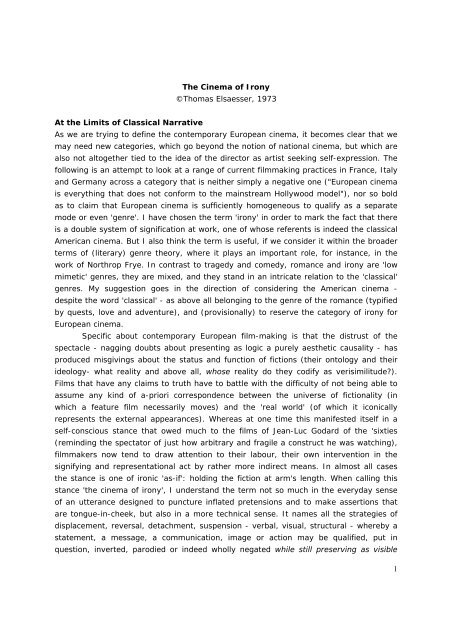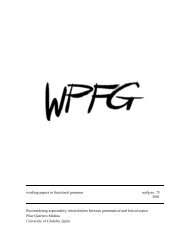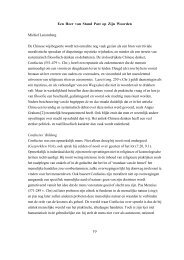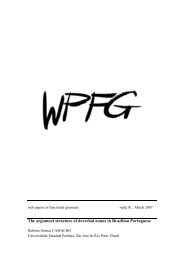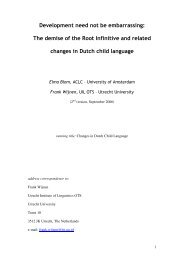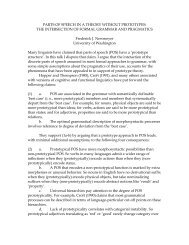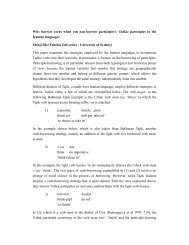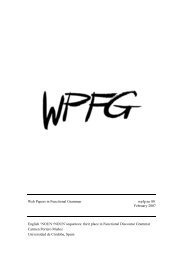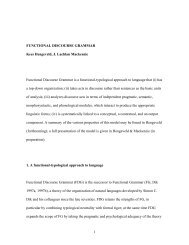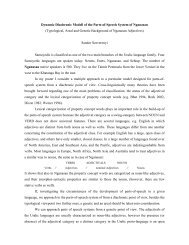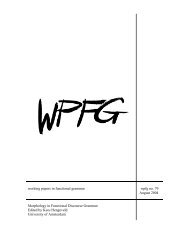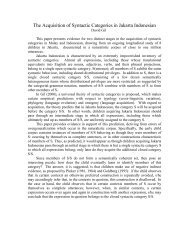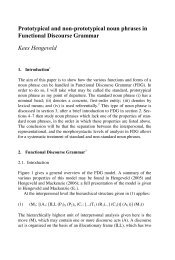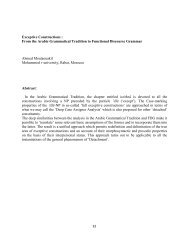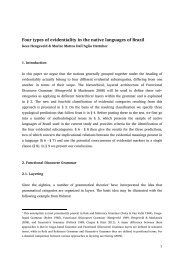Thomas Elsaesser, 'The Cinema of Irony'
Thomas Elsaesser, 'The Cinema of Irony'
Thomas Elsaesser, 'The Cinema of Irony'
Create successful ePaper yourself
Turn your PDF publications into a flip-book with our unique Google optimized e-Paper software.
The <strong>Cinema</strong> <strong>of</strong> Irony<br />
©<strong>Thomas</strong> <strong>Elsaesser</strong>, 1973<br />
At the Limits <strong>of</strong> Classical Narrative<br />
As we are trying to define the contemporary European cinema, it becomes clear that we<br />
may need new categories, which go beyond the notion <strong>of</strong> national cinema, but which are<br />
also not altogether tied to the idea <strong>of</strong> the director as artist seeking self-expression. The<br />
following is an attempt to look at a range <strong>of</strong> current filmmaking practices in France, Italy<br />
and Germany across a category that is neither simply a negative one ("European cinema<br />
is everything that does not conform to the mainstream Hollywood model"), nor so bold<br />
as to claim that European cinema is sufficiently homogeneous to qualify as a separate<br />
mode or even 'genre'. I have chosen the term 'irony' in order to mark the fact that there<br />
is a double system <strong>of</strong> signification at work, one <strong>of</strong> whose referents is indeed the classical<br />
American cinema. But I also think the term is useful, if we consider it within the broader<br />
terms <strong>of</strong> (literary) genre theory, where it plays an important role, for instance, in the<br />
work <strong>of</strong> Northrop Frye. In contrast to tragedy and comedy, romance and irony are 'low<br />
mimetic' genres, they are mixed, and they stand in an intricate relation to the 'classical'<br />
genres. My suggestion goes in the direction <strong>of</strong> considering the American cinema -<br />
despite the word 'classical' - as above all belonging to the genre <strong>of</strong> the romance (typified<br />
by quests, love and adventure), and (provisionally) to reserve the category <strong>of</strong> irony for<br />
European cinema.<br />
Specific about contemporary European film-making is that the distrust <strong>of</strong> the<br />
spectacle - nagging doubts about presenting as logic a purely aesthetic causality - has<br />
produced misgivings about the status and function <strong>of</strong> fictions (their ontology and their<br />
ideology- what reality and above all, whose reality do they codify as verisimilitude?).<br />
Films that have any claims to truth have to battle with the difficulty <strong>of</strong> not being able to<br />
assume any kind <strong>of</strong> a-priori correspondence between the universe <strong>of</strong> fictionality (in<br />
which a feature film necessarily moves) and the 'real world' (<strong>of</strong> which it iconically<br />
represents the external appearances). Whereas at one time this manifested itself in a<br />
self-conscious stance that owed much to the films <strong>of</strong> Jean-Luc Godard <strong>of</strong> the 'sixties<br />
(reminding the spectator <strong>of</strong> just how arbitrary and fragile a construct he was watching),<br />
filmmakers now tend to draw attention to their labour, their own intervention in the<br />
signifying and representational act by rather more indirect means. In almost all cases<br />
the stance is one <strong>of</strong> ironic 'as-if': holding the fiction at arm's length. When calling this<br />
stance 'the cinema <strong>of</strong> irony', I understand the term not so much in the everyday sense<br />
<strong>of</strong> an utterance designed to puncture inflated pretensions and to make assertions that<br />
are tongue-in-cheek, but also in a more technical sense. It names all the strategies <strong>of</strong><br />
displacement, reversal, detachment, suspension - verbal, visual, structural - whereby a<br />
statement, a message, a communication, image or action may be qualified, put in<br />
question, inverted, parodied or indeed wholly negated while still preserving as visible<br />
1
that to which it refers itself ironically. As such, irony is dialectical in intent and invariably<br />
points out a potentially significant gap or break between the signifier and the signified.<br />
The Irony <strong>of</strong> Document and <strong>of</strong> Excess: Werner Herzog and Claude Chabrol<br />
In practice, the cinema <strong>of</strong> irony covers a very wide range. It may be that irony is<br />
structuring the plot, as dramatic irony: a film like Orson Welles' THE IMMORTAL STORY turns<br />
on the trust we invest in the narrator, and the reversal this trust undergoes in the<br />
course <strong>of</strong> the narrative. But irony can also attach itself to a story told 'objectively' across<br />
the interaction <strong>of</strong> different characters. It can be embedded in a neutral delivery, and<br />
remain underplayed to the point where it is no more than a slow-burn energy generating<br />
an oblique ambiguity, as in the films <strong>of</strong> Alain Tanner or Claude Goretta. It may even<br />
embrace two totally opposed kinds <strong>of</strong> cinema. For instance, that <strong>of</strong> Werner Herzog,<br />
where a fiction develops (not in the form <strong>of</strong> a plot, but as a series <strong>of</strong> 'what happens if'<br />
propositions) which only intermittently rises from a documentary flow. Contrast this to<br />
Claude Chabrol's cinema, where the plot foregrounds itself sometimes with an almost<br />
operatic theatricality verging on the Grand' Guignol. What unites the extremes is a<br />
radical suspension <strong>of</strong> naturalistic action and psychological realism, a foregrounding <strong>of</strong><br />
montage-effects which let the image in its presence hover, as it were, between the<br />
possibilities <strong>of</strong> precise meaning and obscure allusion. In the work <strong>of</strong> Herzog, the scenes<br />
are dissolved into 'moments': discrete, suspended, before they become opaque and<br />
solidify into blocks, harsh and uninviting in their unmetaphoric there-ness and facticity:<br />
they are as if actuality material, but without the action. The more these moments - <strong>of</strong>ten<br />
comic, grotesque or pathetic- are presented with the factual neutrality <strong>of</strong> the botanist or<br />
the documentarist, the more they charge themselves with potential meaning. Put<br />
differently, the more 'ironic' they are, the less they lend themselves to a uni-linear,<br />
causally determined, forward movement, acting not only as points <strong>of</strong> retardation, but<br />
blocking altogether the direction <strong>of</strong> meaning within the overall narrative flow. It is as if<br />
these moments - intensely poetic, but laced with violence, such as when a horse is<br />
slipping <strong>of</strong>f the raft in AGUIRRE, or an uprooted palm-tree catches fire in EVEN DWARFS<br />
STARTED SMALL- are epiphanies, rewarding the film-maker when lying patiently in wait for<br />
a reality that is simply and pr<strong>of</strong>oundly itself. Although Herzog, by his own account,<br />
detests both cinéma verité and le direct, the documentary quality <strong>of</strong> his work manifests<br />
itself as a resistance to narrative-generic meaning, holding an image or an action in<br />
suspense as long as possible, before a viewer can absorb them into semantically<br />
determined contexts and thus reduce them to a function <strong>of</strong> the fiction: this resistance,<br />
too, would be a feature <strong>of</strong> the cinema <strong>of</strong> irony.<br />
At the opposite end stands Chabrol. If Herzog is on the side <strong>of</strong> the 'world',<br />
engaged in preserving a pristine irreducibility through the very medium <strong>of</strong> artifice,<br />
Chabrol is all on the side <strong>of</strong> the 'word', demonstrating the all-pervasiveness <strong>of</strong> signs and<br />
designs, <strong>of</strong> language and meaning in the realm <strong>of</strong> objects, motivations, passions and<br />
emotions. In a universe where everything means and nothing can simply be, irony<br />
becomes the figure <strong>of</strong> excess, underscoring the pr<strong>of</strong>usion rather than mitigating it. Films<br />
2
like LE BOUCHER or LA DÉCADE PRODIGIEUSE, with their strongly linear, suspense-oriented<br />
plots, have so many carefully composed symmetrical patterns overlaying but also<br />
deflecting the momentum <strong>of</strong> the story-line that they draw attention to the design itself.<br />
One is reminded <strong>of</strong> Hitchcock, except that in Chabrol the 'plotting' almost amounts to a<br />
counter-structure <strong>of</strong> visual and verbal motifs, superimposing itself on the movements <strong>of</strong><br />
the intrigue, and thereby undercutting its credibility. The effect is to make the film more<br />
discursive, commenting on itself, but also more explicitly an artifice. The irony does not<br />
insinuate itself with the viewer, it coldly keeps him at a distance. As with other directors<br />
who wear their film culture on their sleeve, Chabrol - comparable to Jerzy Skolimowski in<br />
DEEP END and LE DEPART, combines formalism and detachment with an intense moral<br />
stance. A situation is created where the spectator can catch from the discontinuities <strong>of</strong><br />
the narrative a glimpse <strong>of</strong> a rebus-picture <strong>of</strong> another fiction hidden in the foliage <strong>of</strong> the<br />
conventional plot: this double-take works as an ironic reversal, retrospectively installing<br />
another point <strong>of</strong> view.<br />
Fictional Worlds <strong>of</strong> Make-Believe: Alain Tanner and Eric Rohmer<br />
Perhaps the most striking characteristic <strong>of</strong> European cinema today, and one that unites<br />
an uncommonly large number <strong>of</strong> otherwise quite distinct films is the way fiction-making<br />
in one form or another is itself presented as a moral and emotional hazard. As such, its<br />
ironic reversals and pitfalls are taken into the film, to become the constitutive element <strong>of</strong><br />
the intrigue, its secret theme and raison d'être. There, the fiction 'en abime' carves out<br />
<strong>of</strong> the material the ironic space, the reduplication, where the lines <strong>of</strong> meaning, as if<br />
traversing a prism, build up a new narrative architecture. Irony, underscored or deadpan,<br />
chisels away emotion, identification, dramatic assertion or any other form <strong>of</strong><br />
complicity between spectator, protagonists and the director, in order to lay bare the<br />
recesses <strong>of</strong> a visual structure that seems to recede and leave no firm ground at all.<br />
A good example <strong>of</strong> a film where the fiction-making is attributed to the protagonist<br />
is Tanner's Le Salamandre. By choosing as its his hero a writer who wants to play the<br />
journalist-detective, Tanner sets up a mechanism inside the film which generates the<br />
action, as if by itself, almost on behalf <strong>of</strong> the director, who is free to step back and<br />
observe the trap he has set up. The writer and his friend, in their effort to make <strong>of</strong> the<br />
young woman a protagonist in their story, bring about motivations and reactions in their<br />
'subject' which plainly and painfully elude the pattern they attempt to impose. The<br />
woman is too 'real' for this fiction, too honest for this game, she does not respect the<br />
boundaries that should separate (and protect) the teller from the tale. Tanner can let<br />
'reality' spill over into the 'fiction' and vice versa without apparently becoming himself<br />
guilty <strong>of</strong> the charge he levels against his heroes. An ingenious yet open-ended structure<br />
<strong>of</strong> ironic reversal and comeuppance relativises and dissipates any fixed position we<br />
might wish to attribute to the author. In Le Salamandre, the counterpoint to the men's<br />
games is the increasing isolation <strong>of</strong> the young woman. But in her own world <strong>of</strong> private,<br />
3
though socially provoked fantasy, she, too, is fiction-bound. Balancing the asymmetry <strong>of</strong><br />
the two, Tanner makes his presence felt while remaining studiously detached and<br />
'objective'. The filmmaker, engaged in a quest for his characters to reveal themselves,<br />
cannot manifest his commitment other than by emphatically disclaiming responsibility<br />
for the fiction, and pointing to the significance <strong>of</strong> his gesture by a heavy authorial<br />
silence. His irony becomes the guarantee <strong>of</strong> his sincerity, and the film sustains itself by<br />
paradox. The neutral tone and a strategy <strong>of</strong> reversals, <strong>of</strong> parallels and counterpoints,<br />
assumes a degree <strong>of</strong> autonomy that is clearly the product <strong>of</strong> an a-priori conception <strong>of</strong><br />
where the film is going, but it does not presume to know what the action intends to<br />
mean.<br />
Tanner is on comparatively safe ground. His film does not push its ideology <strong>of</strong><br />
ironic self-cancellation beyond the assumption that reality is a complex affair, to be<br />
approached only by way <strong>of</strong> possibly self-defeating bridges thrust into the unknown. Not<br />
quite the same applies to Eric Rohmer, who also tends to place his characters in<br />
situations which make them objects <strong>of</strong> other people's designs. In film after film, a<br />
relationship takes shape, out <strong>of</strong> thin air, at first only toyed as a pleasing conceit, before<br />
it becomes deadly serious. The irony is both superficial and pr<strong>of</strong>ound: the hero enters<br />
into what he takes to be the spirit <strong>of</strong> the occasion, but the badinage soon reveals itself<br />
as an existential vortex with no moral moorings. Chance and opportunity insinuate<br />
themselves, they become a veritable obsession, and the male has no other choice than<br />
to step into the role held out with teasing (dis)ingenuousness by his female antagonist.<br />
The challenge accepted, he comes close to losing his balance, but he just scrapes<br />
through, stepping back to the status quo, but characteristically on terms that make his a<br />
victory look more like defeat, leaving him and his values bare, hollow and exposed. Love<br />
is the dignity-stripper par excellence, at least for the man. From one moral tale to the<br />
next, Rohmer remains faithful to the pattern: LA COLLECTIONEUSE, MA NUIT CHEZ MAUDE, LE<br />
GENOU DE CLAIRE, L'AMOUR L'APRÈS-MIDI. What changes is not the constellation, nor the<br />
nature <strong>of</strong> the game, but the circumstantial forces that void the hero <strong>of</strong> his moral and<br />
emotional substance. Never, however, are these forces confused with reality as such.<br />
Rohmer's strategy is to let one provocation (and being a complacent bourgeois is<br />
provocation enough) fight another. Only limited, self-circumscribed and self-interested<br />
views are allowed to intersect in a discourse that does not demand <strong>of</strong> Rohmer to declare<br />
himself, because the action shapes its trajectory according to the ironic (and thus<br />
structurally satisfying) logic <strong>of</strong> the pyrrhic victory, i.e. <strong>of</strong> 'defeat, snatched from the jaws<br />
<strong>of</strong> victory'. Yet Rohmer's morality is not only a convenient device to hold the narrative in<br />
ambiguous suspension: however charming and engaging his heroes are, they cannot<br />
disguise the fact that their playing games with each other is the result <strong>of</strong> moral<br />
cowardice, but also <strong>of</strong> being idle, rich and blasé: dandies <strong>of</strong> la desinvolture. It makes<br />
their gestures parables <strong>of</strong> irresponsibility and the film a run-through <strong>of</strong> the kinds <strong>of</strong><br />
dissatisfaction that might make even a bourgeois flirt with changing his life. His heroes<br />
almost accept the Pascalian wager, but then in a flurry <strong>of</strong> barely suppressed hysteria,<br />
they run for cover. Sophistication and elegance, finesse and esprit are, so it seems, the<br />
4
products <strong>of</strong> a vacuum. It is this rarefied atmosphere that Rohmer's ironic alo<strong>of</strong>ness<br />
reproduces on a stylistic plane, and it has to stand for the protest that the moral<br />
pessimist in him does not dare to manifest against life as it is lived by the class he<br />
understands so well. In his aesthetic, he would probably like to think <strong>of</strong> himself as a<br />
disciple <strong>of</strong> Fritz Lang, another wily pessimist, particularly in the way Lang, too, allows<br />
chance and contingency to bring about the ironic implosions on which his stories hinge.<br />
Fate (the secret architect <strong>of</strong> the plot) intervenes not on the side <strong>of</strong> fictionality to tidy up<br />
the pattern, but in order to tip the scales in favour <strong>of</strong> apparent incoherence, the<br />
accidental, the unpredictable and incommensurate. Only the hero, in his cocksureness,<br />
can think he has it all worked out. For Rohmer, as for Lang, the world is unknowable,<br />
but it needs fiction to demonstrate this truth.<br />
The Bressonian hero and late Bunuel<br />
By contrast, Robert Bresson IN FOUR NIGHTS OF A DREAMER gives the struggle <strong>of</strong> the<br />
solipsist with his life- denying fantasies a much more sombre colour <strong>of</strong> obsession and<br />
destructive intensity. Possibly because he is not willing to abandon his hero for the<br />
mechanisms <strong>of</strong> ironic detachment, the director refuses to juggle opposites and come<br />
down on the side <strong>of</strong> the merely contingent against the hero. Where Rohmer might<br />
expose to ridicule his protagonist's obstinate pride, such pride in Bresson is invariably<br />
the sign <strong>of</strong> a problematic but inalienable and utterly personal spirituality. For Bresson the<br />
world is not unknowable, nor are his heroes the sum-total <strong>of</strong> their own and other<br />
people's projections. Such grim avoidance <strong>of</strong> irony in structure and tone, despite a<br />
meticulously understated narrative diction is itself a token <strong>of</strong> another irony. Bresson<br />
gives us a clue to the impulse that lies behind treating the fictionality <strong>of</strong> life and the<br />
life-likeness <strong>of</strong> fiction in the ironic mode. The ironist tends to strip or divest the<br />
individual <strong>of</strong> his pretensions to an autonomous self. But he dislodges the trust in an<br />
anthropocentric world-view without wishing to commit himself to any other view <strong>of</strong><br />
reality. Not so Bresson. The dialectic <strong>of</strong> the non-ironic stance serving another irony<br />
which is God's grace makes his heroes' dark night <strong>of</strong> the soul the contrasting foil <strong>of</strong> faith.<br />
In a more gnostic vein, one might add the films <strong>of</strong> André Delvaux, whose protagonists<br />
(in THE MAN WHO HAD HIS HAIR CUT SHORT and BELLE) are obsessed with fictions which the<br />
spectator can see are suicidal, but whose hopelessness gives their actions a special<br />
radiance and purity. Knowing about the danger they court, they persist in stepping<br />
through the mirror, and once again, as in Bresson, the director seems to be on their<br />
side, not wishing to undermine the radiance emanating from the single-minded solitude.<br />
Unlike Bresson, however, no higher irony beckons to receive them when they fail.<br />
All these films, whether fuelled by the irony <strong>of</strong> hesitancy or the irony <strong>of</strong> certainty,<br />
do present themselves as artefacts which are self-contained, 'well-wrought urns', objects<br />
out there, even if this 'out there' does not wish to be mistaken for the real world. They<br />
exist in their suspended realm, a realm not quite philosophical and not altogether wholly<br />
5
given to the senses, by a logic <strong>of</strong> their own. Sometimes they seem to need the presence<br />
<strong>of</strong> an audience less than the audience needs the presence <strong>of</strong> a narrator as guide, but this<br />
is itself part <strong>of</strong> the fiction <strong>of</strong> make-believe: the space <strong>of</strong> (narrative) cinema, at once<br />
wholly self-sufficient and wholly there for the spectator's eyes only. The cinema <strong>of</strong> irony,<br />
it is true, makes a more indirect appeal towards identification, compared to classic<br />
Hollywood film, whose narration is geared towards generating fairly specific emotional or<br />
psychological reactions from the audience. Irony and pointedly neutral observation may<br />
impose on the spectator a more intellectual response <strong>of</strong> cautious and wary interest as<br />
befitting an object <strong>of</strong> uncertain status and meaning. Yet however refracted the action is<br />
across what is perceptually present and what is subjectively imagined, the directors<br />
discussed above have found a way to make the two planes fit. Irony is the force that<br />
lines them up, one against the other and perfectly matched, but it is also the space that<br />
keeps them separate, just enough to stop them fracturing: the collision if and when it<br />
comes, happens in the spectator's head.<br />
Among the things that makes THE DISCREET CHARM OF THE BOURGEOISIE perhaps the<br />
most interesting film in this context is how differently in Bunuel the audience is thought<br />
into this structure <strong>of</strong> double mimesis. He, too, attributes to his protagonists the fictions<br />
and fragments <strong>of</strong> stories and dreams that make up his film, identified as recurrent,<br />
obsessive fantasies - some psychologically plausible, others quite oblique - <strong>of</strong> people<br />
locked into their worlds with manic abandon. A bourgeois dinner party, more and more<br />
openly disgusted with itself is waiting for a kind <strong>of</strong> apocalyptic deliverance that fails to<br />
materialize. However outrageous the guests' and hosts' behaviour, it is tolerated,<br />
because <strong>of</strong> the secrets they all share, as members <strong>of</strong> the same class, family or<br />
associates. In fact, most <strong>of</strong> the time, they seem like conspirators, hatching childish plots.<br />
But if they are truants from life, as it were, their cool, insolent, urbane style makes them<br />
very good company (for themselves and for us). They typify the glamorous and<br />
compelling appeal <strong>of</strong> the cinema as spectacle, and their brazen hedonism and escapism<br />
parodies that <strong>of</strong> the spectator. It is significant that, soon enough, Bunuel chases them<br />
onto the road, into no-man's land. But their pilgrimage is not even in search <strong>of</strong> the<br />
whore that awaited the travellers at the end <strong>of</strong> LA VOIE LACTÉE, which is more than a hint<br />
that Bunuel hopes the spectator will be wondering where the film is taking him. The<br />
images convey the momentum <strong>of</strong> what can barely be called a story only by appearing to<br />
detach themselves from the screen itself. The intrigue breaks open and peels <strong>of</strong>f like<br />
flaky paint, the narrative coils up upon itself, and would do so, even without the<br />
'Saragossa manuscript' device, where each reality turns out to be a dream from which<br />
someone is trying to awake. As it unwinds, the film revolves around an void, projecting<br />
itself onto what is unmistakably a blank space at the horizon <strong>of</strong> the fictional world, which<br />
the spectator must eventually confront on his own, unaided, uncomforted by the<br />
director, whose irony is Olympian in its remoteness. One is tempted to say that the film<br />
has a structure that collapses unless supported by the spectators' effort to sort it out in<br />
his own mind: he is that centre and he completes the circularity <strong>of</strong> an action that has no<br />
real beginning or end. An exemplary 'deconstruction' <strong>of</strong> fictional realism, therefore,<br />
6
ecause the absent centre (as the onion is being peeled) and the stretch <strong>of</strong> country road<br />
(visualizing the metaphor <strong>of</strong> life as a journey) are the film's basic situations from which<br />
its fiction hangs suspended. The road, with the characters shambling along or walking<br />
briskly, either way without making any progress, also connotes the path on which linear<br />
narratives usually travel towards climax and resolution. In its desolation it functions as a<br />
reminder that tight plotting and psychologically coherent motivation must not be<br />
expected <strong>of</strong> this film, nor <strong>of</strong> these stranded individuals. Like the unwilling survivors <strong>of</strong><br />
Godard's WEEKEND, they are on this road people who have not heard the news: the<br />
catastrophe has already happened.<br />
The dialectic inaugurated by Bunuel indicates one direction in which the refusal to<br />
render a self-contained fictional world in the cinema can take the filmmaker beyond<br />
merely asserting a sceptical relativism. A new kind <strong>of</strong> co-operation between spectator<br />
and film will have to replace the old structures <strong>of</strong> complicity. The spectator's expectations,<br />
his anticipated gratifications - even where these are disappointed or frustrated in<br />
the interest <strong>of</strong> suspending reference and reality - will have to return to him as irony. As<br />
the aggregate state <strong>of</strong> possibility and deferred meaning, a cinema that intervenes<br />
through irony and discontinuity is a step towards creating open structures, spaces within<br />
space, and stories within stories, where characters can have a narrative that does not<br />
trap them in a pre-ordained goal. It would be like a new beginning, after the nameless<br />
disasters that make irony so necessary as the negative side <strong>of</strong> sense. Such a space at<br />
the core marks this cinema's vulnerability, but it also gives it a special resonance.<br />
Monogram no.5, 1973<br />
7


